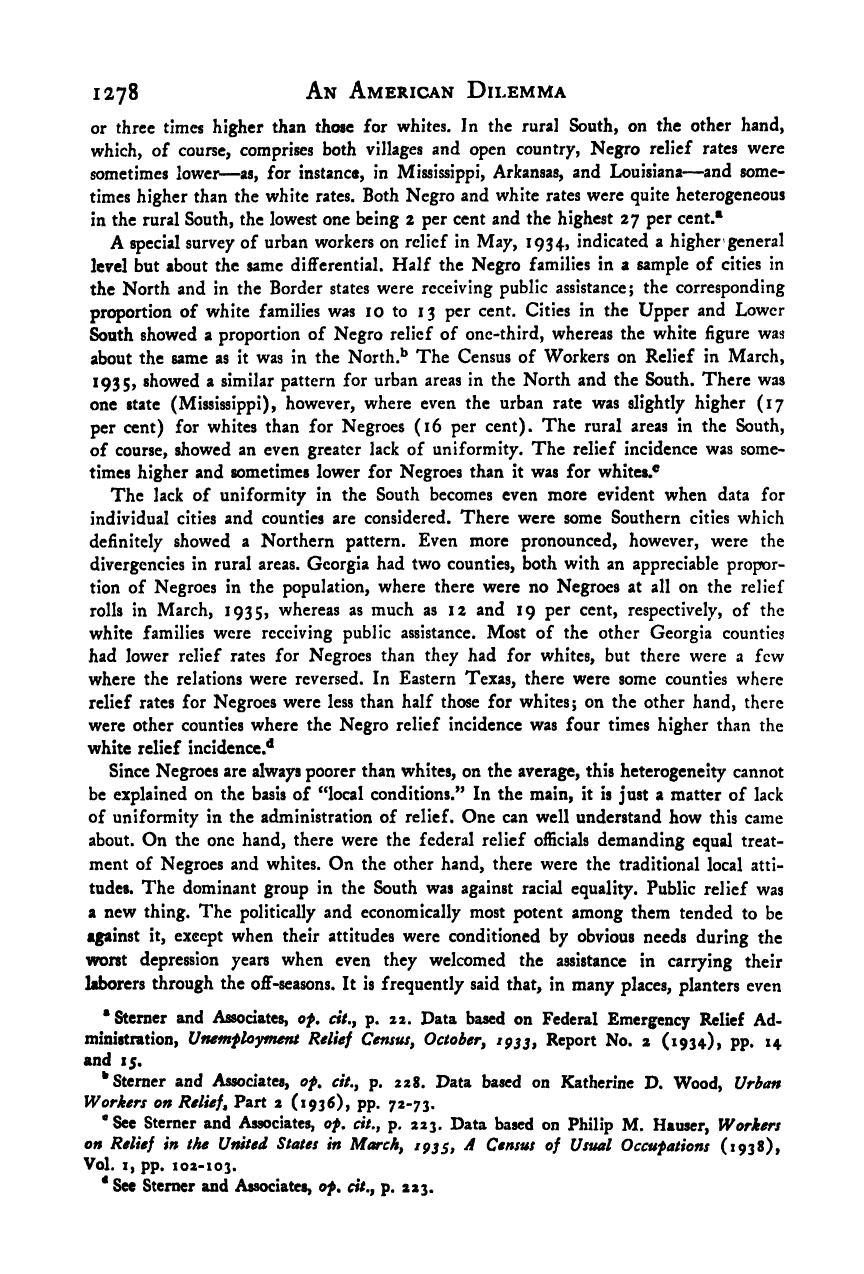Note: Gunnar Myrdal died in 1987, less than 70 years ago. Therefore, this work is protected by copyright, restricting your legal rights to reproduce it. However, you are welcome to view it on screen, as you do now. Read more about copyright.
Full resolution (TIFF) - On this page / på denna sida - Footnotes - Chapter 15

<< prev. page << föreg. sida << >> nästa sida >> next page >>
Below is the raw OCR text
from the above scanned image.
Do you see an error? Proofread the page now!
Här nedan syns maskintolkade texten från faksimilbilden ovan.
Ser du något fel? Korrekturläs sidan nu!
This page has never been proofread. / Denna sida har aldrig korrekturlästs.
1278 An American Dilemma
or three times higher than those for whites. In the rural South, on the other hand,
which, of course, comprises both villages and open country, Negro relief rates were
sometimes lower—as, for instance, in Mississippi, Arkansas, and Louisiana—and some-
times higher than the white rates. Both Negro and white rates were quite heterogeneous
in the rural South, the lowest one being 2 per cent and the highest 27 per cent.*
A special survey of urban workers on relief in May, 1934, indicated a higher’ general
level but about the same differential. Half the Negro families in a sample of cities in
the North and in the Border states were receiving public assistance; the corresponding
proportion of white families was 10 to 13 per cent. Cities in the Upper and Lower
South showed a proportion of Negro relief of one-third, whereas the white figure was
about the same as it was in the North.** The Census of Workers on Relief in March,
1935, showed a similar pattern for urban areas in the North and the South. There was
one state (Mississippi), however, where even the urban rate was slightly higher (17
per cent) for whites than for Negroes (16 per cent). The rural areas in the South,
of course, showed an even greater lack of uniformity. The relief incidence was some-
times higher and sometimes lower for Negroes than it was for whites.®
The lack of uniformity in the South becomes even more evident when data for
individual cities and counties are considered. There were some Southern cities which
definitely showed a Northern pattern. Even more pronounced, however, were the
divergencies in rural areas. Georgia had two counties, both with an appreciable propor-
tion of Negroes in the population, where there were no Negroes at all on the relief
rolls in March, 1935, whereas as much as 12 and 19 per cent, respectively, of the
white families were receiving public assistance. Most of the other Georgia counties
had lower relief rates for Negroes than they had for whites, but there were a few
where the relations were reversed. In Eastern Texas, there were some counties where
relief rates for Negroes were less than half those for whites; on the other hand, there
were other counties where the Negro relief incidence was four times higher than the
white relief incidence.^
Since Negroes are always poorer than whites, on the average, this heterogeneity cannot
be explained on the basis of ‘^local conditions.” In the main, it is just a matter of lack
of uniformity in the administration of relief. One can well understand how this came
about. On the one hand, there were the federal relief officials demanding equal treat-
ment of Negroes and whites. On the other hand, there were the traditional local atti-
tudes. The dominant group in the South was against racial equality. Public relief was
a new thing. The politically and economically most potent among them tended to be
against it, except when their attitudes were conditioned by obvious needs during the
worst depression years when even they welcomed the assistance in carrying their
laborers through the off-seasons. It is frequently said that, in many places, planters even
* Sterner and Associates, of, cit,, p. 22, Data based on Federal Emergency Relief Ad-
ministration, Unemfloyment Relief Census, October, /pjj, Report No. 2 (1934), pp. 14
and 15.
^Sterner and Associates, of, cit,, p. 228. Data based on Katherine D. Wood, Urban
Workers on Relief, Part 2 (1936), pp. 72-73.
* Sec Sterner and Associates, of, cit,, p. 223. Data based on Philip M. Hauser, Workers
on Relief in the United States in March, 193$, A Census of Usual Occufations (1938),
Vol. I, pp. 102-103.
* See Sterner and Associates, of, cit,, p. 223.
<< prev. page << föreg. sida << >> nästa sida >> next page >>